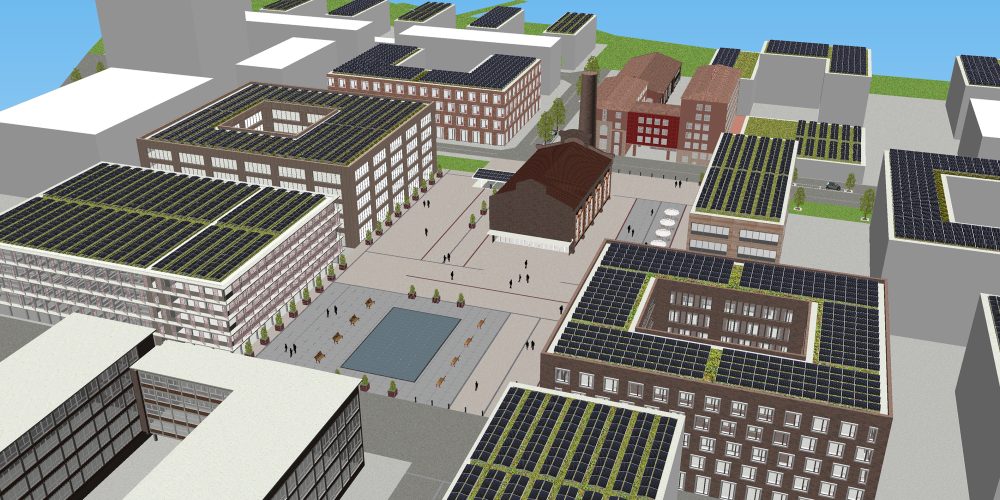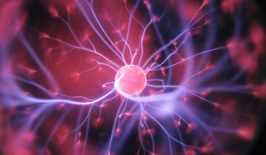Only a few cars can be seen on the streets. Old brick buildings and new buildings are embedded in meadows and parks. If you let your gaze glide over the buildings, you will notice the solar facades and green roofs are equipped with solar cells.
This is the vision of the ‘Reallabors Pfaff’ (Plaff real laboratory) or the EnStadt:Pfaff project near the city centre of Kaiserslautern in western Germany. Where previously the companyPfaff produced sewing machines for 150 years, an innovative, climate-neutral residential, commercial and technology quarter is to be built for 2029. The focus is not only on supplying the buildings with solar power and making mobility sustainable, but also on a variety of digital technologies. As a result, a wide range of organisations are pooling their expertise to make it a reality. In addition to the City of Kaiserslautern and the Fraunhofer Institute for Solar Energy Systems ISE, which are implementing the project, the scientific partners Fraunhofer IESE, IfaS, the University of Kaiserslautern and the Fresenius University of Applied Sciences are also involved.
But How Do You Design and Plan a Climate-Neutral Neighbourhood?
The main building blocks are energy-efficient buildings, the use of renewable energies, the use of battery and heat storage systems and efficient and intelligent mobility solutions. What makes the project special, however, is the interaction of the different sectors with the help of smart grids and a smart energy management system.
The heating market accounts for around 40 per cent of energy-related CO2 emissions; therefore, the heat supply is one of the biggest adjusting screws for a neighbourhood that has set itself the goal of releasing zero emissions into the atmosphere. Local heating networks with low temperatures are particularly suitable for an efficient heat supply to the buildings. Above all, industrial heat, which usually goes to waste, can be used in a relatively uncomplicated way. In the Pfaff Quarter, the heat comes from a groundwater remediation plant on the site, a nearby sewage main collector and industrial waste heat from a neighbouring foundry. What cannot be covered by this is efficiently supplemented by heat pumps. And of course, the classic insulation of buildings is also used here to keep the heat demand low from the start.
At the same time, as much of the energy demand as possible is to be generated on site by renewable energy. The roofs in the Pfaff project, designed as green roofs with photovoltaics (PV), fulfil several tasks at once: “This provides space for retention areas, cools the city and ensures renewable energy production,” says Arne Surmann, who is in charge of the Smart Home, Neighbourhood Monitoring and Agent-based Neighbourhood Energy Management System (EMS) areas of the Reallabors Pfaff at Fraunhofer ISE.
In the Reallabors Pfaff , façades and public spaces also become electricity producers by distributing building-integrated solar panels over a large area. To ensure that as much of the locally produced electricity as possible can also be used on site, decentralised lithium-ion batteries are installed inside buildings, and a 1 MWh redox flow battery will optimise the electricity grid at neighbourhood level.
Lighthouse project EnStadt:Pfaff
The EnStadt:Pfaff project is one of six lighthouse projects that research and demonstrate how the energy transition can be implemented in cities and municipalities using the example of a neighbourhood, and is funded by the Federal Ministry of Economics and Climate Protection (BMWK) and the Federal Ministry of Education and Research (BMBF).
As a real laboratory, the project is characterised by researchers, representatives of the authorities, investors, planners and technology companies working together to develop and test a wide range of technologies and to optimally combine and efficiently use existing technologies.
Another key element of the climate-neutral neighbourhood is the focus on climate-friendly means of transport. Therefore, on the one hand, hardly any parking spaces for cars are planned. At the same time, however, alternative mobility options will be made more easily accessible through digital tools in order to greatly reduce motorised private transport.
“But this is only the operation of the neighbourhoods. A big point, which is often neglected, is the grey energy in the concrete of the buildings. Here, the project created a material database that lists the footprint of individual components and building materials,” Surmann reports.
But what sets the Pfaff Quarter apart is that all sectors are interconnected. Through this so-called sector coupling, electricity and heat can be distributed between the various producers and consumers – i.e. solar systems, heat pumps, electricity storage, electric cars, households.
For this purpose, all electricity consumption meters and other components of the electricity grid are connected to a data network in an electric smart grid and electricity and heat are locally optimised via a digital agent-based energy management system. The novel aspect here is that the energy agents act autonomously and primarily implement the interests of their users. There is no remote control by a central authority, but the users can, for example, set whether agents want to charge their electric car as quickly as possible or as green as possible, or even whether the car is available for vehicle-to-X applications. The personal agent pursues the respective individual goal in connection with the local neighbourhood goals, which can be taken into account in the optimisation, for example through external price incentives and an exchange with other agents.
Ultimately, this intelligent control should massively increase the share of self-supply with renewable energies and save costs.
Why is the Focus Shifting to the Neighbourhood?
As Severin Beucker from the Borderstep Institute also emphasises, there is still a lack of a consistent exchange across the different sectors: “At the moment, we are still thinking in terms of sectors, i.e. ‘buildings’, ‘industry’, ‘mobility’. But we have to think of these problems as systems.” And that is exactly what can be realised very well at the neighbourhood level. By including electric cars, battery storage and heat pumps, the local generation of renewable energy can be directly linked to local consumption by means of finely tuned, small-scale control. And this not only facilitates the switch to renewable energies, but can also relieve the surrounding grid.
At the same time, economic benefits can also arise for the residents and users of the neighbourhood. “The group of residents and tradespeople in inner-city apartment buildings can participate in the energy transition and receive an incentive to jointly equip roofs with PV systems, because there are still large unused areas on these buildings,” says Arne Surmann. But as logical as the exchange of energy between buildings in the neighbourhood may sound, it is not yet possible. What is missing are not technical prerequisites, but the German implementation of the Renewable Energy Community required by the EU from the EU Renewable Energy Directive (RED2 Directive).
“For the topic of neighbourhood EMS, there needs to be an implementation of RED2, which was actually due in July 2021. The German model of tenant electricity is insufficient and too bureaucratic to be scalable in the neighbourhood context. Viable business models are needed to equip all roof surfaces in the neighbourhood with PV green roofs and to bring the energy transition to the residents,” says Arne Surmann. “A positive example of the transposition of the European Directive into national law is the Renewable Energy Community in Austria. And in Switzerland, too, the regulatory framework is already further along than in Germany. I find the Swiss Quartiersstrom very interesting from the point of view of local electricity trading.”

The 1.5 degree target is unattainable without a real transformation of our energy system. But how can it succeed? What are the energy sources of the future? What digital solutions are ready and where are innovations needed? And how can the transformation be driven forward?
The RESET Greenbook “Energy Transition – The Future is Networked” presents digital, innovative solutions and sheds light on the background.
Preparing New Paths to a Climate-Neutral Neighbourhood
Whether the Pfaff Quarter will actually be climate-neutral with these approaches will become clear in the coming years. But in the end, it is not primarily about having developed the concrete project. Rather, Surmann emphasises, it is about showing politicians where the problems lie and what needs to be done so that the energy transition can be completed in the neighbourhoods. To this end, the findings from the project – and above all the things that didn’t work – are collected and reported back to the Federal Ministry of Economics and Climate Protection (BMWK).
And it is precisely here that a lot can still be done, for example by finally creating suitable framework conditions to also use the unused roof space potential in German cities for the energy transition. “PV systems are now available very cheaply and provide CO2-free electrical energy over a period of 20-30 years. The mobility and heat sectors are becoming increasingly electrified. This means that where possible, it should either become mandatory to install modules – not only on new buildings – or better, the regulatory hurdles should fall so that it simply makes economic and ecological sense to install a system,” Arne Surmann demands.










